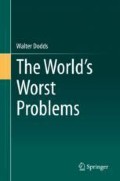Abstract
The beginning of this chapter provides a view on how many people lack adequate nutrition globally. It considers the causes of hunger and the possibilities for feeding a growing human population as standards of living increase worldwide, requiring even more food production. The science behind increasing crop production is explained, the possibility of increasing production adequately considered, and the political obstacles to ending hunger.
Access this chapter
Tax calculation will be finalised at checkout
Purchases are for personal use only
References
Food and Agriculture Organization of the United Nations (FAOSTAT) (2011). http://faostat.fao.org/site/535/DesktopDefault.aspx. PageID
Gerland P, Raftery AE, Ševčíková H, Li N, Gu D, Spoorenberg T et al (2014) World population stabilization unlikely this century. Science 346(6206):234–237
Alexander P, Rounsevell MD, Dislich C, Dodson JR, Engström K, Moran D (2015) Drivers for global agricultural land use change: the nexus of diet, population, yield and bioenergy. Glob Environ Chang 35:138–147
Pauly D, Zeller D (2016) Catch reconstructions reveal that global marine fisheries catches are higher than reported and declining. Nat Commun 7:10244. https://doi.org/10.1038/ncomms10244
Driscoll CT, Mason RP, Chan HM, Jacob DJ, Pirrone N (2013) Mercury as a global pollutant: sources, pathways, and effects. Environ Sci Technol 47(10):4967–4983. https://doi.org/10.1021/es305071v
Crist E, Mora C, Engelman R (2017) The interaction of human population, food production, and biodiversity protection. Science 356(6335):260–264. https://doi.org/10.1126/science.aal2011
Fischer T, Byerlee D, Edmeades G (2012) Crop yields and food security: will yield increases continue to feed the world. In: Proceedings of the 12th Australian agronomy conference, pp 14–18. Australian Centre for International Agricultural Research (ACIAR), Bruce AU
Childers DL, Corman J, Edwards M, Elser JJ (2011) Sustainability challenges of phosphorus and food: solutions from closing the human phosphorus cycle. Bioscience 61(2):117–124
Gurian-Sherman D (2009) Failure to yield: evaluating the performance of genetically engineered crops. Union of Concerned Scientists, Cambridge, MA
Eisenhut M, Weber APM (2019) Improving crop yield. Science 363(6422):32–33. https://doi.org/10.1126/science.aav8979
Ray DK, Ramankutty N, Mueller ND, West PC, Foley JA (2012) Recent patterns of crop yield growth and stagnation. Nat Commun 3:1293
Mueller ND, Gerber JS, Johnston M, Ray DK, Ramankutty N, Foley JA (2012) Closing yield gaps through nutrient and water management. Nature 490(7419):254–257
WWAPU (2015) The United Nations world water development report 2015: water for a sustainable world. United Nations World Water Assessment Programme, Paris
Gleeson T, Wada Y, Bierkens MF, van Beek LP (2012) Water balance of global aquifers revealed by groundwater footprint. Nature 488(7410):197
Egan T (2006) The worst hard time: the untold story of those who survived the great American dust bowl. Houghton Mifflin Harcourt, Boston
Pimentel D, Harvey C, Resosudarmo P, Sinclair K, Kurz D, McNair M et al (1995) Environmental and economic costs of soil erosion and conservation benefits. Science 267(5201):1117–1123
D’Odorico P, Bhattachan A, Davis KF, Ravi S, Runyan CW (2013) Global desertification: drivers and feedbacks. Adv Water Resour 51:326–344
Collier P (2010) The plundered planet: why we must--and how we can--manage nature for global prosperity. Oxford University Press, New York
Godfray HCJ, Beddington JR, Crute IR, Haddad L, Lawrence D, Muir JF et al (2010) Food security: the challenge of feeding 9 billion people. Science 327(5967):812–818
Author information
Authors and Affiliations
Rights and permissions
Copyright information
© 2019 Springer Nature Switzerland AG
About this chapter
Cite this chapter
Dodds, W. (2019). Hunger. In: The World's Worst Problems . Springer, Cham. https://doi.org/10.1007/978-3-030-30410-2_5
Download citation
DOI: https://doi.org/10.1007/978-3-030-30410-2_5
Published:
Publisher Name: Springer, Cham
Print ISBN: 978-3-030-30409-6
Online ISBN: 978-3-030-30410-2
eBook Packages: Mathematics and StatisticsMathematics and Statistics (R0)

